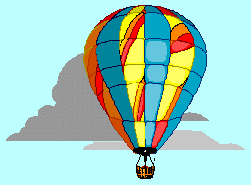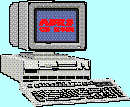|
Aeronaut
Adventures
In many ways, ballooning is
not very different from any other type of flying. The  challenges are similar, as are
the some of the hazards. Some aeronaut reporters to ASRS share a few of
their "hot air" stories with us. challenges are similar, as are
the some of the hazards. Some aeronaut reporters to ASRS share a few of
their "hot air" stories with us.
Capricious
Winds--and Fortune
More so than in powered flight,
hot air ballooning is at the mercy of the "wind gods" who often
offer up capricious winds, or sometimes no winds at all. A controller's
report provides evidence:
- Two hot
air balloons departed near the exterior boundaries of the ATA [Class
D Airspace]. Because of winds, they entered the ATA and became a factor
for several aircraft.
These balloonists probably
wanted to fly out of the ATA as much as the controller wanted them to,
but most likely couldn't tell ATC this. Even though a few balloonists
carry handheld radios, most are incommunicado.
A Kiss, Not
a Miss
- Contact
with another hot air balloon...fabric-to-fabric [and] no damage to either
aircraft. I should have looked closer behind and below.
This no-damage mid-air collision
is known as a "kiss," and might have been avoided had the reporter
given way to the lower balloon. This incident serves as a gentle reminder
to all pilots to review right-of-way rules--and to see and avoid.
Low-Level
Hazards
- Launched
in good VMC conditions. While I was performing high altitude maneuvers,
ground fog started to form. I maneuvered with reference to objects projecting
above the fog, and began a slow descent. I established ground contact
at approximately 100-200 feet AGL. Primary cause of the incident was
not being more aggressive about landing at the first sign of fog formation.
Not every pilot has such a
benign encounter with unforecast IMC. This pilot was fortunate to be able
to descend with out interference from powerlines, trees, or some other
obstacle hidden in the fog--unlike our next aeronaut:
- Another
pilot and I were floating up a river [in a balloon] when we came upon
some well hidden powerlines. We brushed the lines, but no damage occurred.
Powerlines, especially those
embedded in trees, continue to be a hazard to all types of low-flying
aircraft. Pilots are responsible for determining when low-level flight
is safe and appropriate, and when it is simply not worth the risk.
Notable Landings
An unwritten rule for hot air
balloonists is never to pass up a good landing site for a poor one. As
such, some aeronauts recall their notable landing sites.
- Our flight
finally started 50 minutes prior to sunset. I became concerned with
lack of landing sites and closeness to sunset. Finally, with only 15
minutes before sunset, I landed in the center of a highway cloverleaf.
Luckily for this reporter,
the local police were more curious than punitive...
- I landed
in a suitable area at a school. The Vice-Principal approached and advised
me that summer school was in session and the property was off limits.
Some state Departments of Aeronautics
strictly control aircraft landings on school property (usually only K-12),
regardless of whether or not the school is in session.
- I was flying
over the lake, winds went calm...and we decided to land the balloon
in [a friend's] boat. I elevated the basket, he slipped under with the
boat, and I sat it down in the boat and collapsed the envelope.
According to our reporter,
the need for an ASRS report arose when "one of the boats reported
to the local FAA that the balloon had 'crashed' in the lake..." This
was probably not the first time a balloon has needed a little help getting
to shore.
Another aeronaut needed help getting out of the "pen":
- The wind
was picking up on the surface. I decided to land in the hayfield directly
in front of us. We were met by two Corrections Department employees,
informing us that we had landed on prison property!
A Note To Our
Readers
The April issue of Callback experienced unexpected productions delays
that will result in readers receiving it much later than usual. The May
issue should be produced on time. We regret this departure from our usual
schedule.
Runway Excursions...
Excursion is usually defined
as a short journey, an outing, or a pleasure tour. The alternate definition,
relevant to ASRS, is a digression, literally "going away" from
a runway or taxiway, usually inadvertently. In the following report, the
pilot experienced both types of excursions. It is likely that the reporter
will remember the ASRS definition long after the pleasure tour is forgotten!
- I was flying
to this uncontrolled grass airport to visit relatives living nearby.
Because of a delay, I did not arrive at the field until dusk. As such,
I made my approach slightly faster and higher than normal. When my main
gear touched down, I placed the flap selector in the retract position
because I felt I needed the additional braking authority that would
give me. My aircraft went into the ditch at the end of the runway. The
nose wheel folded into the well, and the prop was slightly damaged.
[Later], I discovered that my flaps were still in the full extended
position [and] the flap control was in the retract position where I
had placed it. I then found that the flap circuit breaker had popped,
apparently at the time that I extended the flaps.
I believe this incident could have been avoided by better adherence
to short field landing techniques, and a pre-landing cockpit check of
circuit breakers.
...And Landing
Diversions
The flip side of this month's
CALLBACK reports on memorable landings experienced by hot air balloonists.
Reporters in powered aircraft have slightly different stories to tell.
Open fields are usually favored for unplanned airplane landings. Frequently,
however, these fields are not without hidden hazards:
- ...[Landed]
in the only field available to me. There was a rusty old barbed wire
fence hidden in the high grass. I believe that when the plane caught
the fence, it caused the plane to turn over.
Occasionally, there are no
hazards:
- The engine
quit. Landed in hay field. No damage. Restart successful. Took off on
road.
Any uninhabited
expanse long enough for an aircraft rollout may be suitable:
- Past the
end of the fishing piers, over the ocean...my engine quit without warning.
I was able to glide the aircraft to the water's edge of the beach and
make a safe emergency landing.
A four-lane highway is often
a good alternative runway, and all that asphalt perhaps provides some
confidence:
- I told ATC
that a four-lane highway [was nearby]. I chose a stretch of road which
would permit an uphill approach and landing...while giving traffic behind
me plenty of time to slow down..
Of course, an airport is always
the best choice, and what looks more inviting than 15,000 feet of Air
Force Base run way?
- Radio calls
all went unanswered, [and] I followed the wrong freeway. After squawking
7600 and searching for an airport, I found [the Air Force Base], where
I was given a steady green light for landing. I was allowed to takeoff
after filling out the necessary paperwork.
As the old saying goes, "A
good landing is any landing you can walk away from."
The
ASRS Database On CD-ROM
 The ASRS database
is widely regarded as one of the world's premier sources of information
on aviation safety and human performance. Over the years, ASRS has received
thousands of requests for database information. In 1994 alone, ASRS satisfied
632 requests for ASRS incident data. The ASRS database
is widely regarded as one of the world's premier sources of information
on aviation safety and human performance. Over the years, ASRS has received
thousands of requests for database information. In 1994 alone, ASRS satisfied
632 requests for ASRS incident data.
Requesters use ASRS data for many purposes. ASRS data are particularly
useful for accident prevention, procedures training, aviation education,
safety analysis, human factors studies, and scenario development for Line
Oriented Flight Training (LOFT) and Advanced Qualification Program (AQP)
applications.
The ASRS database is now available on CD-ROM. Users can have quick, effective
access to ASRS data and search parameters can be tailored or modified
as required.
The ASRS CD-ROM disc contains over 50,000 full-form incident records,
covering the most recent five years. It also contains over 100,000 abbreviated
format records (useful in statistical analyses). Users can carry out simple
or complex searches on any combination of fixed or textual fields. The
user can search on keywords specified by ASRS Analysts, browse and print
user-selected records, and export data for use in word processing, spreadsheet
analysis, database and other programs.
Computer Requirements. The ASRS CD-ROM is currently available for
DOS only, and requires an IBM (or true compatible) 386 or higher PC, with
at least 640 KB RAM, DOS 3.31 or above, and an ISO 9660 compatible CD-ROM
drive.
Order Information. The product is available through AeroKnowledge,
Inc. of Pennington, New Jersey. Their telephone number is (609) 737-9288,
or fax (609) 730-1182. Call them for more information.
ASRS Recently Issued Alerts
On...
- An uncommanded engine overspeed
on a B757-200
- Bear repellent canisters
on Part 135 flights in Alaska
- Late distribution of Class
II NOTAMs and AIM revisions
- Improper installation of
a bearing assembly in a jet engine
- Reports of improper baggage
loading on commuter flights
February 1995 Report Intake
- Air Carrier Pilots--1771
- General Aviation Pilots--613
- Controllers--63
- Cabin/Mechanics/Military/Other--23
- TOTAL--2470
|

